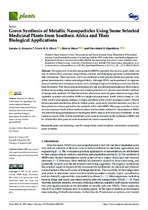| dc.contributor.author | Sibuyi, Nicole Remaliah Samantha | |
| dc.contributor.author | Meyer, Mervin | |
| dc.contributor.author | Aboyewa, J.A. | |
| dc.contributor.author | Oguntibeju, O.O. | |
| dc.date.accessioned | 2021-10-04T07:39:36Z | |
| dc.date.available | 2021-10-04T07:39:36Z | |
| dc.date.issued | 2021 | |
| dc.identifier.citation | Aboyewa, J. A., Sibuyi, N. R. S., & Meyer, M. (2021). Green synthesis of metallic nanoparticles using some selected medicinal plants from Southern Africa and their biological applications. MPDI. DOI: 10.3390/plants10091929 | en_US |
| dc.identifier.issn | 22237747 | |
| dc.identifier.uri | 10.3390/plants10091929 | |
| dc.identifier.uri | http://hdl.handle.net/10566/6860 | |
| dc.description | This research was supported by the Cape Peninsula University of Technology (CPUT-RJ23) granted to OO Oguntibeju and “The APC was funded by M.M. and O.O.O”. | en_US |
| dc.description.abstract | The application of metallic nanoparticles (MNPs), especially that of silver, gold, cobalt, and zinc as antimicrobial, anticancer, drug delivery, contrast, and bioimaging agents has transformed the field of medicine. Their functions, which are attributed to their physicochemical properties, have gained prominence in various technological fields. Although MNPs can be produced via rigorous physical and chemical techniques, in recent years, a biological approach utilizing natural materials has been developed. With the increasing enthusiasm for safe and efficient nanomaterials, the biological method incorporating microorganisms and plants is preferred over physical and chemical methods of nanoparticle synthesis. Of these bio-entities, plants have received great attention owing to their capability to reduce and stabilize MNPs in a single one-pot protocol. South Africa is home to ~10% of the world’s plant species, making it a major contributor to the world’s ecological scenery. Despite the documented contribution of South African plants, particularly in herbal medicine, very few of these plants have been explored for the synthesis of noble MNPs. This paper provides a review of some important South African medicinal plants that have been utilized for the synthesis of MNPs. The enhanced biological properties of the biogenic MNPs attest to their relevance in medicine. In this endeavor, more of the African plant biodiversity must be explored for the synthesis of MNPs and be validated for their potential to be translated into future nanomedicine. © 2021 by the authors. Licensee MDPI, Basel, Switzerland. | en_US |
| dc.description.sponsorship | Cape Peninsula University of Technology (CPUT): CPUT-RJ23 | en_US |
| dc.language.iso | en | en_US |
| dc.publisher | MDPI | en_US |
| dc.subject | Antimicrobial | en_US |
| dc.subject | Cytotoxicity | en_US |
| dc.subject | Green nanotechnology | en_US |
| dc.subject | Green synthesis | en_US |
| dc.subject | Medicinal plants | en_US |
| dc.subject | Metallic nanoparticles | en_US |
| dc.subject | Anticancer | en_US |
| dc.subject | Bioimaging agents | en_US |
| dc.subject | Physicochemical properties | en_US |
| dc.subject | South Africa | en_US |
| dc.subject | Herbal medicine | en_US |
| dc.subject | Silver Nanoparticles; Acid Gold Tetrachloride; Biofabrication | en_US |
| dc.subject | Acid gold tetrachloride | en_US |
| dc.subject | Biofabrication | en_US |
| dc.title | Green synthesis of metallic nanoparticles using some selected medicinal plants from southern africa and their biological applications | en_US |
| dc.type | Article | en_US |

